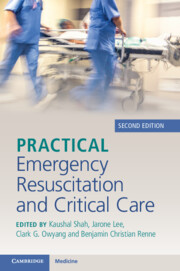Book contents
- Practical Emergency Resuscitation and Critical Care
- Practical Emergency Resuscitation and Critical Care
- Copyright page
- Contents
- Contributors
- Preface
- Section 1 General Critical Care
- Section 2 Infectious Disease Emergencies
- Section 3 Neurological Emergencies
- 12 Ischemic Strokes
- 13 Intracranial Hemorrhage
- 14 Status Epilepticus
- 15 Acute Spinal Cord Compression
- Section 4 Cardiovascular Emergencies
- Section 5 Respiratory Emergencies
- Section 6 Gastrointestinal Emergencies
- Section 7 Renal Emergencies
- Section 8 Hematology–Oncology Emergencies
- Section 9 Endocrine Emergencies
- Section 10 Environmental Emergencies
- Section 11 Trauma
- Section 12 End of Life
- Index
- References
15 - Acute Spinal Cord Compression
from Section 3 - Neurological Emergencies
Published online by Cambridge University Press: 02 November 2023
- Practical Emergency Resuscitation and Critical Care
- Practical Emergency Resuscitation and Critical Care
- Copyright page
- Contents
- Contributors
- Preface
- Section 1 General Critical Care
- Section 2 Infectious Disease Emergencies
- Section 3 Neurological Emergencies
- 12 Ischemic Strokes
- 13 Intracranial Hemorrhage
- 14 Status Epilepticus
- 15 Acute Spinal Cord Compression
- Section 4 Cardiovascular Emergencies
- Section 5 Respiratory Emergencies
- Section 6 Gastrointestinal Emergencies
- Section 7 Renal Emergencies
- Section 8 Hematology–Oncology Emergencies
- Section 9 Endocrine Emergencies
- Section 10 Environmental Emergencies
- Section 11 Trauma
- Section 12 End of Life
- Index
- References
Summary
Acute spinal cord compression results from impingement on the spinal cord due to a variety of etiologies, including neoplasm, hemorrhage, infection or other structural abnormality at any vertebral level.
Any patient who presents with a history of trauma, intravenous drug use (IVDU) or immunocompromised state with associated neurological deficit and/or back pain should be evaluated for acute cord compression.
Neoplastic disease is rarely confined to a single location; therefore, the entire spine should be evaluated when metastatic disease is suspected.
- Type
- Chapter
- Information
- Practical Emergency Resuscitation and Critical Care , pp. 131 - 138Publisher: Cambridge University PressPrint publication year: 2023



